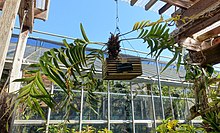| Zamia pseudoparasitica | |
|---|---|

| |
| Conservation status | |
 Near Threatened (IUCN 3.1) | |
| CITES Appendix II (CITES) | |
| Scientific classification | |
| Kingdom: | Plantae |
| Clade: | Tracheophytes |
| Clade: | Gymnospermae |
| Division: | Cycadophyta |
| Class: | Cycadopsida |
| Order: | Cycadales |
| Family: | Zamiaceae |
| Genus: | Zamia |
| Species: | Z. pseudoparasitica |
| Binomial name | |
| Zamia pseudoparasitica J.Yates | |

| |
| Zamia pseudoparasitica is endemic to Panama | |
| Synonyms | |
| |
Zamia pseudoparasitica is a species of plant in the family Zamiaceae. It is endemic to Panama.
Habitat
Its natural habitat is subtropical or tropical moist lowland forests on the Atlantic side of the isthmus. It is threatened by habitat loss.
Description
Zamia pseudoparasitica is the only known species of Zamia that is epiphytic. Furthermore, it is the only known obligate epiphytic gymnosperm. growing on the branches of forest trees. It has a very short trunk but long leaves over 3 m long. The seeds are orange.
The root system can be very long and may reach and root in the ground in some cases. Taproots of 15 m in length have been documented.
Cytology
The diploid chromosome count of Zamia pseudoparasitica is 2n = 16.
Ecology
Pollination
The beetle Notorhopalotria taylori appears to be the main pollinator of Zamia pseudoparasitica. The beetle lives in the male cones of Zamia pseudoparasitica.
Seed dispersal
The seeds are thought to be disseminated by northern olingo,Toucans, or potentially by fruit-eating bats.
Conservation
Primary forest is an important habitat for this species, as it has been unable to re-colonize secondary forests within a timeframe of 50 years.
Horticulture
Some attempts have been made to bring the plant into cultivation as a plant to be grown in a hanging basket, with some degree of success. Watering should be done with soft, slightly acidic water. The substrate, which may be composed of coco chips, bark, moss, and anorganic materials like pumice and perlite, should be kept moist and should not dry out completely.
References
- ^ Taylor, A. (2010). "Zamia pseudoparasitica". IUCN Red List of Threatened Species. 2010: e.T42175A10648571. doi:10.2305/IUCN.UK.2010-3.RLTS.T42175A10648571.en. Retrieved 17 November 2021.
- Zamia pseudoparasitica | CITES. (n.d.). Retrieved July 8, 2023, from https://cites.org/eng/taxonomy/term/41785
- ^ "Zamia pseudoparasitica J.Yates". Plants of the World Online. Royal Botanic Gardens, Kew. Retrieved 7 July 2023.
- The Plant List
- 2006 IUCN Red List of Threatened Species. Archived June 27, 2014, at the Wayback Machine Downloaded on 24 August 2007.
- Schuster, Julius. 1932. Das Pflanzenreich (Engler) 4, Fam. 1: 142, as Zamia pseudoparasitica var. latifolia
- Correa A., M.D., C. Galdames & M. Stapf. 2004. Catálogo de las Plantas Vasculares de Panamá 1–599. Smithsonian Tropical Research Institute, Panama
- Stevenson, D. W. 1993. The Zamiaceae in Panama with comments on phytogeography and species relationships. Brittonia 45(1): 1–16.
- ^ Monteza-Moreno, C. M., Rodriguez-Castro, L., Castillo-Caballero, P. L., Toribio, E., & Saltonstall, K. (2022). Arboreal camera trapping sheds light on seed dispersal of the world’s only epiphytic gymnosperm: Zamia pseudoparasitica. Ecology and Evolution, 12, e8769.
- ^ Bell-Doyon, Philip & Villarreal A., Juan. (2020). "New Notes on the Ecology of the Epiphytic Gymnosperm and Panamanian Endemic Zamia pseudoparasitica" Board of Editors. 2. 1-7.
- Alberto S. Taylor B., Jorge Mendieta, Ronald Bernal, and Gaspar Silvera. (2008). "Strange but True A Never-Before-Reported Characteristic of Zamia pseudoparasitica." The Cycad Newsletter, 31, 8–9.
- Caputo, P., Cozzolino, S., Gaudio, L., Moretti, A., & Stevenson, D. W. (1996). Karyology and Phylogeny of Some Mesoamerican Species of Zamia (Zamiaceae). American Journal of Botany, 83(11), 1513–1520. https://doi.org/10.2307/2446105
- Moretti, A., & Sabato, S. (1984). Karyotype Evolution by Centromeric Fission in Zamia (Cycadales). Plant Systematics and Evolution, 146(3/4), 215–223. http://www.jstor.org/stable/23671504
- O’Brien, Charles & Tang, William. (2015). Revision of the New World cycad weevils of the subtribe Allocorynina, with description of two new genera and three new subgenera (Coleoptera: Belidae: Oxycoryninae). Zootaxa. 3970. 1-87. 10.11646/zootaxa.3970.1.1.
- Leila Nilipour, Caught red handed: The mystery of an unusual Panamanian plant’s dispersal, Smithsonian Tropical Research Institute
- Clayton York, Utopia Palms & Cycads, Palm & Cycad Society of Australia, Zamia pseudoparasitica
- Seemann, Berthold Carl. 1854. Botany of the Voyage of H.M.S. ~Herald~ 2: 202, 253, Zamia pseudoparasitica
- Kuntze, Carl Ernst Otto. 1891. Revisio Generum Plantarum: vascularium omnium atque cellularium multarum secundum leges nomeclaturae internationales cum enumeratione plantarum exoticarum in itinere mundi collectarum ... Leipzig 2: 803, as Palmifolium pseudoparasiticum
- Stevenson, D. W., R. Osborne & J. Hendricks. 1990. A world list of cycads. Memoirs of The New York Botanical Garden 57: 200–206.
- Lavaud, S. (2023, May 25). Zamia pseudoparasitica care sheet. Cycadales. Retrieved July 17, 2023, from https://cycadales.eu/2023/05/25/zamia-pseudoparasitica-care-sheet/?lang=en
| Taxon identifiers | |
|---|---|
| Zamia pseudoparasitica |
|